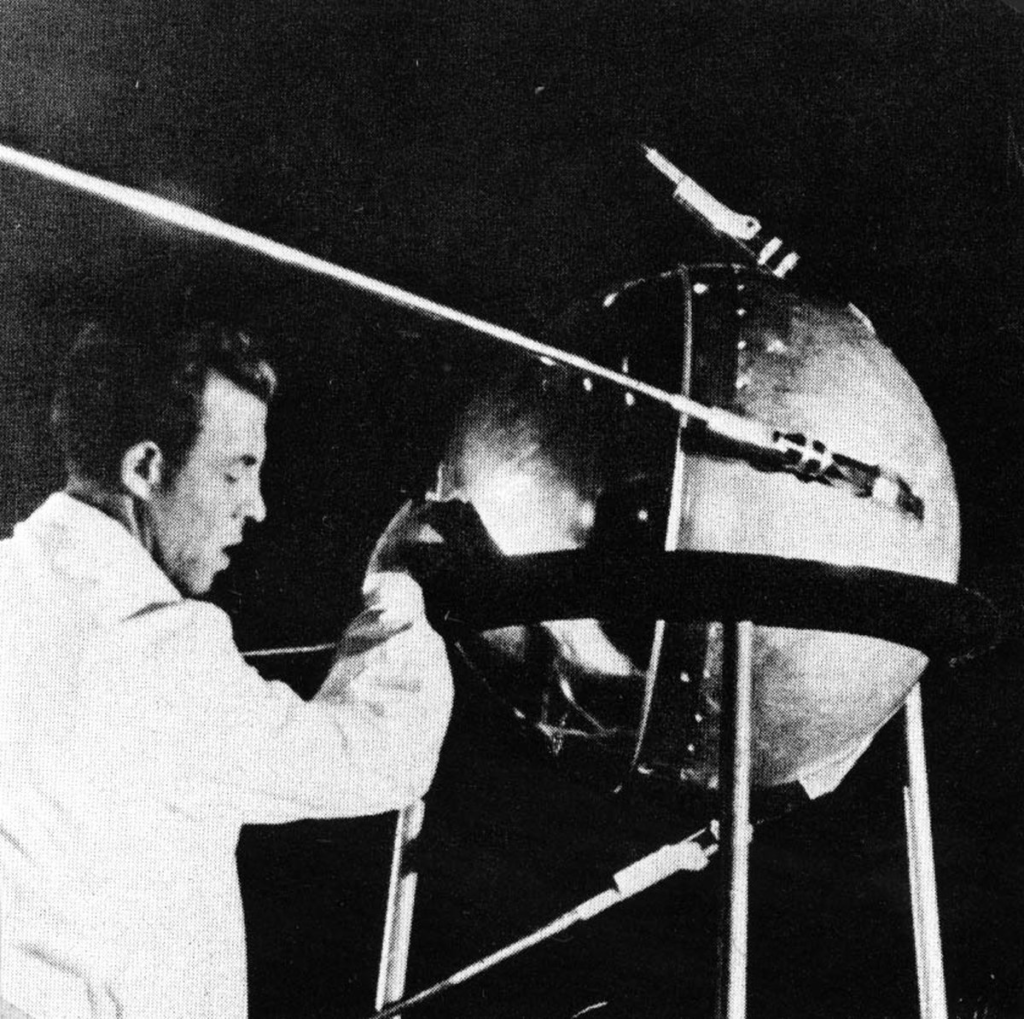Your cart is currently empty!
Introduction to Communication Satellites
Back to: Communications Satellites Connecting the World
Overview
This lesson provides a foundational understanding of communication satellites, their purpose, and their importance in our interconnected world. By exploring the basic components, functions, and historical context of these technological marvels, participants will gain a comprehensive introduction to the role satellites play in modern communication networks.
Learning Objectives:
By the end of this lesson, participants will:
- Understand what communication satellites are and their key roles.
- Identify the main components of a communication satellite.
- Recognize the significance of satellite technology in global connectivity.
- Appreciate the early milestones that set the stage for modern satellite systems.
What Are Communication Satellites?
Imagine a small village nestled deep in a mountain valley where no cables or cell towers can reach. How does a person from this village connect with the world? This is where communication satellites come into play. Positioned thousands of kilometers above the Earth, these satellites act as mirrors in the sky, receiving signals from one location and bouncing them back to another.

For example, when you make an international phone call or stream a live event, your signal travels from your device to a nearby ground station. From there, it is beamed up to a satellite orbiting the Earth and then sent down to a receiving station in another country. This process occurs in a fraction of a second, enabling seamless global communication. Without satellites, the world as we know it—interconnected and fast-paced—would not exist.
Satellites help overcome barriers such as oceans, mountains, and deserts, providing critical support during natural disasters when traditional communication infrastructure is unavailable. They are indispensable for GPS navigation, internet services in remote areas, and even military operations. These devices not only connect individuals but also drive economies and ensure safety in emergencies.
Components of a Communication Satellite
To perform their functions effectively, communication satellites are equipped with intricate systems designed to operate in the harsh environment of space. Each component is meticulously engineered to ensure reliability, longevity, and the capability to withstand the extreme conditions of space.
Transponders: The transponder is often referred to as the brain of the satellite. It is tasked with receiving signals from Earth, amplifying them, and altering their frequencies before sending them back. This amplification not only strengthens the signals but also prevents interference from the original frequencies. Modern satellites are equipped with dozens of transponders, enabling them to handle thousands of communication streams simultaneously, from television broadcasts to internet data transfers.
Antennas: Satellites are fitted with multiple antennas, each designed for specific tasks. Parabolic antennas, for instance, are highly efficient in focusing and directing radio waves to specific points on Earth. These antennas ensure precise targeting, minimizing signal loss. Meanwhile, phased array antennas provide advanced capabilities by electronically steering the signal beams, allowing for real-time adjustments without the need for mechanical movement. This technology has revolutionized how satellites manage dynamic and varied communication demands.
Power Systems: Power is a critical aspect of any satellite’s operation. Large solar panels, often extending several meters, harness energy from the Sun to power all onboard systems. These panels are made from high-efficiency photovoltaic cells designed to endure the intense radiation of space. During eclipses or when a satellite passes through the Earth’s shadow, rechargeable batteries seamlessly take over, ensuring that the satellite’s functions remain uninterrupted. Some newer satellite models even incorporate advanced energy storage technologies to extend operational periods during power constraints.
Propulsion Systems: Maintaining a satellite’s precise orbital position is vital for consistent communication. Propulsion systems employ thrusters powered by chemical propellants or ion engines, which provide fine control over the satellite’s trajectory. For geostationary satellites, the need for accuracy is even greater; a deviation of just a few kilometers can disrupt their ability to serve a specific region. Propulsion systems also assist in de-orbiting satellites at the end of their lifecycle, reducing space debris and ensuring sustainable use of orbital slots.
Thermal Control Systems: Space is an environment of extremes, with temperatures swinging between scorching heat and freezing cold. Thermal control systems are designed to protect a satellite’s sensitive electronics and instruments. Heat is dissipated using radiators, while insulation layers shield against excessive cold. These systems work in harmony to maintain an optimal operational temperature, ensuring the satellite’s longevity and functionality.
Payloads and Specialized Equipment: Depending on their purpose, satellites often carry additional payloads. For instance, weather satellites are equipped with advanced sensors and cameras to monitor climatic patterns, while scientific satellites may carry spectrometers and telescopes for research purposes. Each payload is custom-built to maximize the satellite’s contribution to its intended mission.
To perform their functions effectively, communication satellites are equipped with intricate systems designed to operate in the harsh environment of space. Each component is meticulously engineered to ensure reliability and longevity.
Thermal Control Systems: In space, extreme temperatures can damage sensitive components. Thermal control systems regulate the satellite’s temperature, ensuring that instruments operate within their specified range.
Transponders: The transponder is often referred to as the heart of the satellite. When a signal reaches the satellite, the transponder amplifies it and changes its frequency before transmitting it back to Earth. This amplification ensures the signal remains strong and avoids interference with the original. Modern satellites often carry multiple transponders to handle a variety of communication tasks simultaneously.
Antennas: Antennas are crucial for capturing and transmitting signals. For instance, a parabolic antenna focuses signals into narrow beams, ensuring they reach their intended destination with precision. Some satellites have phased array antennas, which can electronically steer beams without moving parts, offering greater flexibility.
Power Systems: Communication satellites rely heavily on solar panels to generate the energy required for their operations. These panels are designed to withstand radiation and provide consistent power for years. During periods when the satellite is in the Earth’s shadow, onboard batteries kick in to ensure uninterrupted functionality.
Propulsion Systems: Contrary to popular belief, satellites don’t simply float in space. Precise positioning is essential to maintain their functionality. Propulsion systems, powered by chemical or electric thrusters, help satellites maintain their orbits and make necessary adjustments. For geostationary satellites, even minor drifts can disrupt communication.
A Glimpse Into History

The history of communication satellites is a testament to human ingenuity and our drive to connect. The journey began in 1957 with the launch of Sputnik, the first artificial satellite, by the Soviet Union. Although Sputnik was not a communication satellite, it marked the beginning of the space age and inspired further advancements.
In 1962, the United States launched Telstar, the first satellite capable of relaying live television broadcasts. Telstar made history by enabling the first transatlantic television broadcast, allowing viewers in Europe and the United States to watch the same event simultaneously. This achievement was a major milestone, proving that satellites could bridge continents in real-time.
The development of geostationary satellites, based on the theoretical work of Arthur C. Clarke, further revolutionized the field. These satellites remain fixed relative to a point on Earth, making them ideal for continuous communication services like television and internet.
Today, satellite constellations like Starlink by SpaceX represent the next frontier. Consisting of thousands of small satellites in low-Earth orbit, these constellations aim to provide high-speed internet to even the most remote corners of the planet. Such advancements have transformed not only how we communicate but also how we live, making satellite technology an integral part of modern life.
Reflection and Discussion
To deepen your understanding of communication satellites, consider the following:
- Discuss the role of satellites in addressing global challenges, such as bridging the digital divide in underserved regions or monitoring climate change.
- Imagine a world without satellites. How would this impact global communication, navigation, and emergency services? Reflect on the domino effects this absence might create.
- Think about the history of satellite technology. Which milestone do you find most impactful, and why? How might the visionaries of the past view today’s advancements?
Copyright 2024 MAIS Solutions, LLC All Rights Reserved
